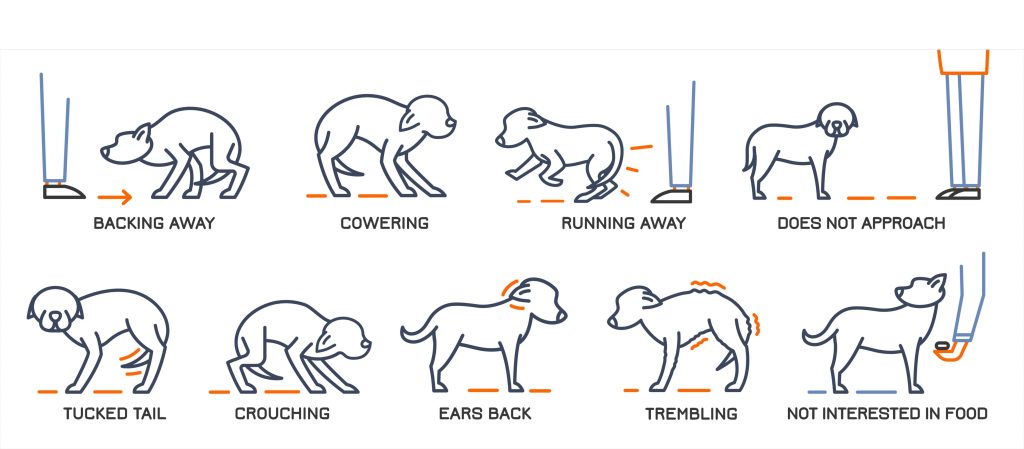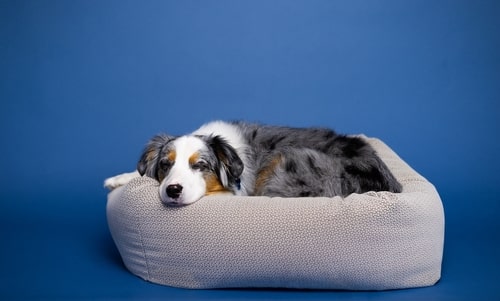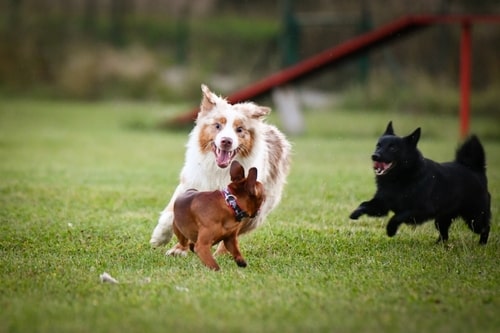Help for Reactive Dogs
Causes
Symptoms
What to do
What not to do
When is reactivity normal in dogs?
Prevention
When to worry
Help for Reactive Dogs
Any dog can become reactive, but it’s more likely to occur in dogs over one year old than in puppies. Genetics, previous traumatic experiences and lack of appropriate socialisation as a puppy are some of the risk factors.
Often reactive dogs are fearful dogs, and if the early signs are missed, this can escalate to aggression, such as biting and snapping. Medical conditions such as pain can make reactivity worse, so it’s important to seek advice from a vet for any reactive dog. The good news is, many reactive dogs can be retrained over time with the advice from a qualified behaviourist and owner dedication.
What causes dogs to be reactive?
There are many reasons and sometimes more than one is involved. This can include medical causes, the dog's environment, and past experiences. Any medical condition that makes a dog feel unwell or painful can make them more likely to react aggressively. Here are some common medical causes.
Medical Causes:
Once medical causes have been investigated by a vet, behavioural and environmental causes can be addressed. This should be done with a qualified behaviourist.
Behavioural Causes:
Arousal or excitement especially in young energetic dogs
Fear or anxiety when the dog cannot get space from the trigger
Frustration when the dog can’t get to what they want to
Territorial and protective behaviour when a dog is guarding
Predatory behaviour especially with dogs that love to chase
Possessive behaviour when a dog guards food or toys
Learned behaviour when the response is repeated and becomes habit
Environmental causes:
Previous punishment can suppress subtle signs and cause the dog to escalate to aggression
Traumatic experiences such as a dog attack can cause fear and reactivity to certain dogs in the future
Lack of early or appropriate socialisation to new people, animals, places and things can cause dogs to fear these things when they are older
Lack of appropriate training can lead to the reactivity getting out of control
It’s helpful to know what triggers the reactivity and observe your dog's body language to understand what’s causing them to react. Common scenarios include reactivity on the lead, reactivity to certain dogs, strangers, cars and loud noises. Reactive behaviour when repeated often becomes a habit over time.

Often a range of emotions can be involved. These can include fear, anxiety, frustration and excitement. Previous traumatic experiences such as a dog attack, can cause fear and reactivity to certain dogs in the future. If a dog hasn’t been properly socialised as a puppy this can also lead to fear.
Why is my dog reactive on the lead?Lead reactivity is a common complaint. This is often caused by excitement or frustration at not being able to get to the other dog. It can also be due to fear, which can turn into an aggressive response to try and increase space from the other dog.
Why is my dog reactive to cars?Some dogs lunge and try to chase cars. This can be because of their inner prey drive. Breeds with a high prey drive, such as Sighthounds and Terriers, can be more prone to chase behaviours. Dogs can also be scared of cars and loud traffic and this can be linked to noise phobias.
Why is my dog reactive to strangers?Reacting to strangers can also be due to fear, anxiety or frustration. This can be due to a lack of socialisation as a puppy, causing fear to dogs, people or things. Territorial behaviour such as barking at windows and doors is common towards delivery people or visitors. This can often lead to aggressive behaviour.
Spotting the signs of fear and reactivity in dogs
As well as looking at what triggers the reactivity, observing your dog’s body language is essential. Taking video footage is a good idea. This will help the vet and behaviourist understand how they are feeling and the best way to help. Often reactive behaviour is a learned habit, and sometimes it may feel sudden without any warning. But often there are helpful clues to look out for. Unpredictable reactivity or aggression can be more challenging to treat.
Fear is a common driving emotion in the start for reactive dogs. It’s important to spot the signs of fear because bites and attacks often occur if the early signs are missed. When dogs are scared or fearful of something, their ‘flight or fight’ instinct kicks in. In other words, if they aren’t able to get away from the scary thing, they may resort to fighting to create more space from the trigger. Frustrated dogs can show behaviours including jumping up, mouthing and pawing. This can be confused with fear and anxiety.
Signs of a fearful dog
Facial expression:
Ears back
Lip licking
Yawning
Wide eyes
Avoiding eye contact
Tight mouth
Panting
Body posture:
Cowering or low posture
Shaking
Hackles raised
Tail tucked
Hiding away
Paw lifting

This can lead to freezing in an aroused state or moving slowly. Signs include ears upright, stare fixed on threat, tense body with tail held stiff.
Displacement behaviours can come next such as becoming hyperactive, rolling over to show belly or jumping up. This is the dog becoming less able to cope.
The last resort is to fight if they cannot get space from the trigger. That’s when bites and attacks can happen.
What to do if your dog is reactive
Seeking advice from a vet and behaviourist is the best thing to do, especially if there is aggression involved. Dogs repeat what they practice, so the longer the reactive behaviour is left, the worse it can get. Putting them in a situation where they react can make the problem worse.
If your dog is showing aggression, it’s important to stay safe. Keep them away from young children, anyone, or anything that can trigger the behaviour.
Tips to stay safe
Avoid situations that trigger the reactive behaviour
Walk them in quiet areas without other people and dogs
Warn passers by to give your dog space and avoid approaching them
Use a freedom field or alternative activities like puzzle toys in the garden
Muzzle training is a good idea for aggression, a behaviourist can help you do this safely and positively
What to do if your dog reacts
When a dog reacts, they are in an aroused state and are unlikely to listen to you. Do not try to approach or stop a reactive dog. Reactive and fearful dogs need time and space to calm down.
Gently move them away from the situation to a quiet, safe area
Allow them time and space to calm down
Some dogs will need to rest at home to ‘cool off’
Use calming activities such as scatter feeding
Positively reward calm behaviour with high-value treats
A qualified behaviourist can help you train useful cues like emergency ‘U turn’ and ‘Watch me’ using high value treats. This will help your dog focus on you and get out of sticky situations.
How do I stop my dog from being reactive?
A qualified behaviourist can make a behaviour modification plan to help. This often involves ‘counterconditioning’ the dog to the triggers.
Counterconditioning is teaching the dog to associate the trigger with something positive so they don’t react anymore
Consistency and patience from the owner is needed to help the dog learn
Starting at a far away distance from the trigger, the dog is rewarded with high value treats when they don’t react
This distance is gradually reduced over time as the dog learns not to react
If the dog shows fearful or reactive behaviour they should go back a step in the training plan where they feel comfortable
Some dogs need behaviour-modifying drugs from the vets to help them with the training
Depending on the triggers, some behaviourists will advise controlled training with the triggers if it’s safe to do so. For example, dogs that get frustrated on the lead but are fine off the lead can practice with another calm dog that they get on with. Sometimes pretend dogs can be used if the dog is aggressive or not able to safely socialise.
How do I find a qualified behaviourist?
Your vet or online Joii vets can refer you to a qualified, accredited behaviourist. It is extremely important to find someone qualified who uses kind, ethical, and up-to-date techniques. Beware of people practicing as behaviourists who aren’t suitably qualified or use outdated, harmful methods.
The following organisations can also help you find a qualified behaviourist in your area:
ABTC (Animal Behaviour and Training Council) is a regulatory body that sets and maintains standards for the profession and has a national register for appropriately qualified animal trainers and behaviourists.
CCAB (Certified Clinical Animal Behaviourist) is an accreditation scheme by the ASAB (Association for the study of animal behaviour).
FAB (Fellowship of Animal Behaviour Clinicians) has a list of certified members and promotes high ethical standards and up-to-date techniques.
APBC (Association of Pet Behaviour Counsellors) is a network of experienced and qualified counsellors.
Tips to help at home
Dogs are less likely to react when they are feeling calm and relaxed. Making sure all their needs are met, including food, exercise, play and sleep is a good start. Keep them away from anything that triggers the reactive behaviour at home too. For example you can block windows and doors and keep them away from these areas if they react to passers by. For dogs that ‘resource guard’ or react to toys and food, give them space and don’t approach when eating or playing with toys. A behaviourist can help you safely teach a ‘leave it’ cue.

Make sure they have a consistent routine
Give them plenty of exercise, play and undisturbed rest
Create a cosy den in a quiet place to hide
Put their favourite blankets, toys and treats in the den
Use calm activities such as food-stuffed Kongs and lick mats
Encourage them to use their nose with scatter feeding and puzzle toys
Praise calm behaviour with their favourite treats and toys
Calming diffusers and products
Calming diffusers such as Adaptil or Pet Remedy can help
Adaptil collars are good for out and about
Use these alongside a behaviour modification plan
Speak to our Joii team for advice on environmental changes and products that can help calm your dog.
Dogs and kidsMost dog bites are with children in their own homes and these can have terrible consequences for everyone involved. Many of these are preventable so education is key for all of the family. Understanding your dog’s body language and spotting the early signs before they react or bite is important. If your dog is reactive or aggressive around children keep them safely away from the kids, and speak to a vet and qualified behaviourist for advice as soon as possible.
Top tips to stay safe:
Supervise closely, never leave your dog and children alone and be ready to intervene calmly if needed. Crawling and toddling children are especially unpredictable.
Use barriers such as baby gates but watch for young children poking their fingers through.
Give your dog their own quiet space to sleep, eat and play undisturbed.
Avoid your dog being disturbed when they are eating, chewing or playing.
Avoid hugs and kisses, especially on their faces. Loud noises and unwanted strokes and tugs are also stressful for them.
If your dog has behaviour issues around children, it's essential to speak to a vet and qualified behaviourist before the problem gets worse. A plan can be made to help the specific situation. In some cases rehoming or other options need to be considered. Our friendly Joii vet and behaviour team can help.
What not to do when your dog reacts
Avoid punishment as this can lead to fear, anxiety and sometimes aggression
Don’t give them attention when they react as this can reinforce the behaviour
Never use disruptive methods such as shock collars, this can make things worse
Instead focus on calming activities and rewarding calm behaviour
When is reactivity normal in dogs?
There are some situations where dogs look like they are reacting but it’s actually normal behaviour. Observing their body language and getting to know the early warning signs when your dog isn’t feeling comfortable is key.
Playing
Dogs are sociable creatures and often love to play. However, play behaviour can look similar to aggressive behaviour. It can also lead to aggression especially if the dogs are different ages, energy levels or sizes. Short supervised play sessions with dogs of similar energy levels can help. Older dogs are less likely to want to play especially if they have arthritis, pain or problems that can lower their tolerance threshold.

Puppy biting
Puppies love to play and explore the world with their mouths. This means they like to bite and chew and this can often be on furniture, hands and legs. Teaching your puppy to redirect chewing to appropriate chew toys such as puppy Kongs can help. Speak to a Joii vet nurse for more advice on this.
How do I prevent my dog from being reactive?
Early and appropriate socialisation as a puppy is key. This starts as early as 4 weeks old with the breeder. The sensitive period is around 4 to 16 weeks when puppies are little sponges to new experiences. Try and expose them to a variety of positive experiences. It’s important not to ‘flood’ your puppy, though, as this can make them fearful. Instead, allow them to approach new people, dogs or things in controlled meets, at their own pace. Keep sessions short and sweet.
Keeping up training using positive rewards is also helpful throughout your dog's life. Young dogs between 6 and 18 months going through social and sexual maturity can push boundaries. They often need to go back to basics with their training at this age.
When to worry
Changes in behaviour happen for a reason so it’s always a good idea to have your dog checked by a vet. Pain is one of the major causes of behaviour changes and the signs can be subtle. Arthritis or joint pain is especially common in adult and older dogs.
Common signs of pain include:
Quieter or depressed
Crying, whimpering or being more vocal
Reacting to being touched or moved
Unable to settle or get comfortable
Hunched, tense or change in posture
Limping, stiff or slowing down
Less keen for walks, play, jumping or climbing
More attention-seeking or avoiding interactions
Eating less or going off food
Speak to one of our Joii vets if you are concerned your dog is in pain. The vet can assess your dog and give you instant advice.























